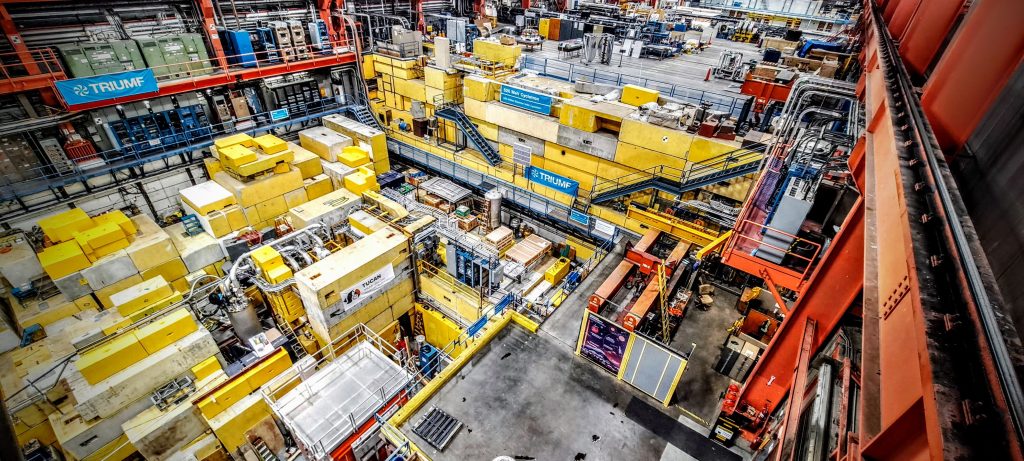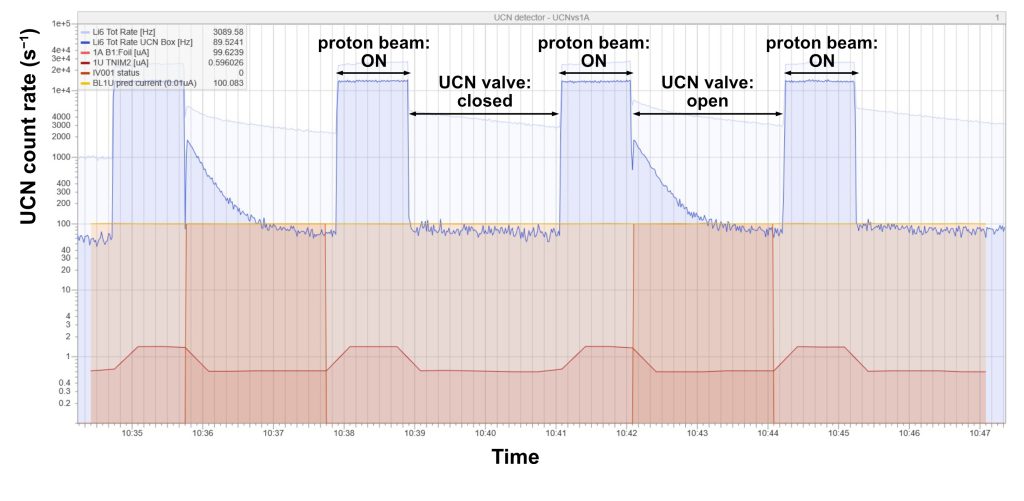First Successful Operation of the Advanced Ultracold Neutron Source at TRIUMF
On the 13th of June, 2025, the TRIUMF Ultracold Advanced Neutron (TUCAN) international collaboration, in which the Institute for Integrated Radiation and Nuclear Science, Kyoto University (KURNS) participates, successfully produced ultracold neutrons (UCN) at TRIUMF, Canada’s Particle Accelerator Centre.

FIG. 1: The TRIUMF Meson Hall, where the TUCAN experiment is located. Part of the UCN source is visible at the centre of the photo.
UCNs are neutrons that have been cooled to extremely low energies—on the order of 100 nano-electronvolts. Because of their low energy, they can be confined in material containers for several hundred seconds, allowing high-precision studies of the fundamental properties of the neutron. Although electrically neutral, neutrons may possess a minute separation of electric charge—an electric dipole moment (EDM). The existence of a finite neutron EDM would imply a violation of time-reversal symmetry—one of the fundamental symmetries of the laws of physics. This, in turn, is directly connected to CP (charge-parity) symmetry violation, which is believed to underlie the matter–antimatter asymmetry of the universe. In this context, the neutron EDM has profound implications in particle physics. The TUCAN experiment aims to produce large numbers of UCNs for a high-precision measurement of the neutron EDM, with the ultimate goal of probing time-reversal symmetry violation at unprecedented sensitivity.
In the UCN production scheme of TUCAN, proton beams from a cyclotron accelerator are impinged on a metal target to induce spallation reactions, producing fast neutrons. These neutrons are then cooled in stages, with the final stage utilising inelastic scattering in superfluid helium [1]. In 2017, a prototype UCN source developed in Japan was transported to TRIUMF, enabling the first successful production of UCNs at TRIUMF [2]. Since then, development has continued on a new, advanced UCN source designed to deliver UCNs at world-leading intensity [3].
In the latest experiment conducted in June 2025, the team successfully confirmed UCN production from the TUCAN source. The measured UCN production rates were in good agreement with predictions based on simulations, even though the liquid deuterium moderator—required for efficient deceleration of fast neutrons—had not yet been installed. With its installation planned, the collaboration is now poised to advance towards full-performance operation of the UCN source and the upcoming neutron EDM experiment.

FIG2: Response of the UCN detector recorded during the experiment. The blue line shows the counting rate of the UCN detector. During proton beam irradiation, the detector also responds to gamma rays and fast neutrons produced in the surroundings, causing increased counting rates. After the beam is turned off , opening the valve that extracts UCNs from the production region allows detection of the UCNs.
For further details, please see TRIUMF’s official news release:
https://triumf.ca/2025/06/30/new-ultracold-neutron-source-produces-record-for-canada/
The following researchers from RCNP are participating in this project:
From KURNS, Assistant Professor Takashi Higuchi and Ph.D. student Ryuto Fujitani are part of the TUCAN collaboration. Furthermore, a method for diagnosing cold neutron fluxes from the UCN source was developed at the CN-3 beamline of the Kyoto University Research Reactor (KUR), with support from Professor Masahiro Hino and Assistant Professor Takushi Takata, together with the participation of exchange student Antoine Beaudouin (Grenoble INP – Phelma). A UCN source based on a superfluid helium converter is also proposed at the new research reactor that is planned to be built on the Monju site in Tsuruga, Fukui prefecture. The experience and knowledge gained through TUCAN are expected to contribute to the development of this future facility.
This project is supported by the following funding bodies and programmes:
the Canada Foundation for Innovation; the Canada Research Chairs program; the Natural Sciences and Engineering Research Council of Canada (NSERC) (SAPPJ-2016-00024,
SAPPJ-2019-00031, and SAPPJ-2023-00029); British Columbia Knowledge Development Fund; Research Manitoba; JSPS KAKENHI (Grant Nos. 18H05230, 19K23442, 20KK0069, 20K14487, and 22H01236); JSPS Bilateral Program (Grant No. JSPSBP120239940); JST FOREST Program (Grant No. JPMJFR2237); International Joint Research Promotion Program of Osaka University; RCNP COREnet; the Yamada Science Foundation; the Murata Science Foundation; the Grant for Overseas Research by the Division of Graduate Studies (DoGS) of Kyoto University; Joint Usage/Research of the Institute for Integrated Radiation and Nuclear Science, Kyoto University (KURNS) (R6055,R6056), and the Universidad Nacional Autonoma de Mexico – DGAPA program PASPA and grant PAPIIT AG102023.
References
[1] Y. Masuda et al. Phys. Rev. Lett. 108, 134801 (2012).
[2] S. Ahmed et al. (TUCAN collaboration), Phys. Rev. C 99, 025503 (2019).
[3] W. Schreyer et al., Nucl. Inst. Meth. A 959, 163525 (2020); R. Mastumiya et al., JPS Conf. Proc. 37, 020701 (2022)




